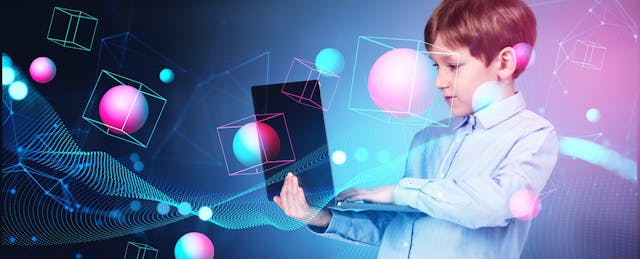Personalized learning has been a buzzword in education since the turn of the century. But what does it really mean? This past fall, I met with several education leaders to discuss this very topic and codify what it looks like in the classroom.
Defining personalized learning
Technology is associated with personalized learning for a variety of reasons. As we can’t truly be a one-to-one ratio teacher to student, using devices becomes important to help student learning be genuinely personal. Lindsey Blass, an education specialist at Adobe, mentions that it’s much more than students plugging into devices while following some self-guided playlist. “We see personalized learning as students really having agency and ownership in their learning experience,” she shared.
Differentiation plays a role in the definition of personalized learning as well. Zareen Poonen Levien, the director of digital learning at San Francisco Unified School District (SFUSD), suggests that technology can be leveraged to fully engage a student to give them choice and creativity. “A really important part of it is that students feel like they belong and have a place in the classroom,” she shared. Studies do show that deeper learning happens when students have this sense of being understood.
Student agency also plays an important role in personalized learning. Students thrive when they have a choice in what they learn and how they engage with the content, such as “having a way for them to demonstrate their learning that makes the most sense for them,” adds Rebecca Hare, a community engagement manager at Adobe. Identifying all these different pathways for students to demonstrate their learning is the basis for high-quality personalized learning.
The current state of education and why personalized learning matters
Identifying personalized learning practices is the first step, but putting those practices into action can seem challenging. Teachers who feel overwhelmed while also managing district and state mandates will struggle to create an optimal personalized learning environment. Levien works in a large urban district and has seen firsthand the struggles of teaching and learning during and after Covid with interrupted classes and student absenteeism, symptoms of the trauma and uncertainty many students felt.
This year, we’ve also seen an influx of new teachers as many experienced teachers have left the profession. While it’s exciting to have fresh energy, it also means a lack of support staff to truly help with interventions and extensions of learning. So without this support, creating an environment where students have that sense of agency and belonging is essential. Technology plays a major role in increasing engagement and getting students excited about their learning.
One major takeaway from the pandemic is that we don’t necessarily need to do direct synchronous instruction all the time. Hare mentions using video to record short, direct teaching sessions, allowing students to rewatch lessons at their own pace and time. It also allows the teacher to make more time for one-on-one or small-group interactions.
Students aren’t the only ones who need to feel empowered in their learning. Blass mentions how important it is for teachers to also feel that sense of ownership and choice when it comes to how they teach and learn.
Steps for schools to go from traditional to personal
San Francisco USD dedicated much time and energy to bringing personalized learning into the classroom. They met with staff, students, leaders and parents to interview their community and figure out what personalized learning truly meant.
“The first step is identifying the ideal state [of personalized learning] and then recognizing the current state to identify that gap in between,” Blass says. This process takes much more than just a single person or department. It is a collaboration from all stakeholders, determining mission-driven actionable steps.
What an ideal personalized learning space looks like
Just like instructional practices, the environment can strongly affect personalized learning outcomes. An ideal space is flexible so that the students can create, make, debate, collaborate and ultimately engage in the activities. “There is no magical stool or table that’s going to fix this for everybody,” Hare states. Rather than hanging posters on the wall for the entire year, have students put their artifacts for learning on display instead. Small touches, like letting students choose the song of the day for when they enter the classroom, give them a little extra ownership in the classroom environment.
While it’s easy to see physical changes like extra devices and flexible furniture, Hare mentions how important it is to invest time in teachers' mindsets before you purchase. It doesn’t take a lot from the budget to make some small shifts in the learning environment to make it more personalized. One extra consideration that Blass mentioned was that as a teacher, it’s acceptable to create your own space in the classroom. Teachers spend most of their waking hours in their classroom, so why not make it a more comfortable and creative space?
Watch the full “The Role of Technology in Personalized Learning” webinar on-demand now.
Making personalized learning ubiquitous
One of the challenges of personalized learning is getting all the teachers in a building to buy in and believe in what is possible. Giving teachers a chance to see each other in action is much more impactful than attending a training discussing personalized learning theory. Getting substitute teachers so that teachers can observe others is one way, but in SFUSD, they also utilize video. Since many of the teachers were already comfortable with Zoom due to the pandemic, recording themselves and sharing with colleagues is a simple and less intimidating option.
The role of technology in personalized learning
The main purpose of this webinar was to discuss the role technology plays in personalized learning. While it certainly plays a role, it’s really about finding “the tools that enable the right behavior,” Levien mentions. This is beyond using adaptive software; it’s about making thinking visible.
The panel also mentions that it’s important for staff to have a core set of tools to use. We want to give students choices regarding tools to make their learning visible. However, we can also overwhelm them with options. A school doesn’t need to have 50 different apps for creating. Focusing on creative tools like Adobe Express allows students to do many things, like making a website, portfolio or video to express their learning, all within one program.
Honing in on a few evergreen tools that can be used in multiple subjects with multiple outputs rather than giving students lots of consumptive tools, personalized learning focuses on the tools that invite creativity. Schools owe it to students to give them opportunities to be producers more than consumers, a skillset that will serve them well in their futures. That’s a goal of any technology used in a personalized environment: to encourage individual student growth in authentic competencies.



